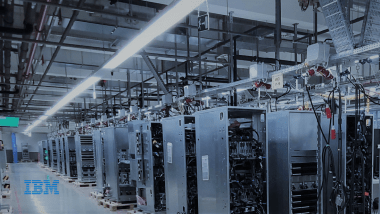
IBM’s digital journey is keenly focused on building a cognitive enterprise that embraces an agile culture of innovation, combined with a client focus that leverages exponential technologies to deliver greater value. IBM executives on the MLC’s recent virtual tour of its high-end storage manufacturing plant in Vác, Hungary, described it as, “a mission of relentless reinvention.”
The April 2021 tour showed Manufacturing Leadership Council members how the company brings that mission to life to maximize its complex supply chain. And it is a complex one: IBM has an operational presence in more than 170 countries around the globe, with its manufacturing sites in strategic locations, serving hundreds of thousands of customers with hardware deliveries and service maintenance. To meet the high configurable product demand, the IBM supply chain operates in a hybrid model of build-to-plan and build-to-order. IBM also collaborates with suppliers across its global, multi-tier supplier network.
For IBM, the enterprise IT needed to drive rapid innovation is based on an Open, Hybrid Cloud and AI-embedded platform that incorporates the company’s own technology, including IBM’s Watson AI capability, to provide data insights as well as manage its supply chain on a daily basis. IBM AI technology has capabilities to co-create and manage business transformation through visual recognition technology, acoustic analytics, industrial augmented reality, IoT, blockchain, and digital twins, to power its infrastructure, elevate its automation capability, maximize equipment lifespan, and enable remote support.
But it also takes IBM’s team of passionate and committed supply chain professionals to apply these emerging technologies to operations with both speed and agility to achieve the company’s goal of relentless reinvention.
From piloting new technologies to becoming a more cognitive enterprise, automating core processes, and leveraging a multi-source more resilient supply chain, IBM is committed to the idea of innovating anywhere/use everywhere data insights to improve its processes, people, and technology.
Adopting Advanced Technology to Drive Digital Transformation
The Hungary plant tour exemplified how IBM combines collaboration and processes with automation, AR, AI, IoT, and data visibility to achieve a seamless, agile operation. Supported by the company’s Operations and Supply Chain Execution teams around the world, some of the key technologies IBM executives highlighted included:
Supply Chain Advisor: Being able to access forecast, order, supply, inventory, and engineer data in real time across all manufacturing geographies and functions is critical to the company’s decision-making process. IBM uses a platform powered by Watson and cognitive AI capabilities to provide instant data insights that its worldwide supply chain professionals can use to monitor and assess global and local supply and demand information, as well as parts numbers and component details. There are three main Advisor systems: Cognitive Supply Chain Advisor 360, Quality Advisor, and Test Advisor, which enables the IBM Supply Chain to mitigate potential issues before they reach critical mass and to adjust workflows as needed.
Collaborative Robots: The company also uses collaborative robots integrated with AI visual recognition to help maintain consistency in the quality inspection process, as well as precision in the assembly process. This allows employees to concentrate on more complex and higher value tasks.
Acoustic Insights: IBM infuses AI and automation into the acoustic arena as well. It trains AI models to recognize sounds that could indicate a potential machine failure so it can be mitigated before a failure occurs. Both of its visual and acoustic insight products were developed in house.
Augmented Remote Assistance: When the company had to minimize the physical interaction of employees due to COVID-19, it implemented an augmented remote assistance solution — a mobile app and web interface that workers can use to report problems to remote experts. The experts can then evaluate and provide step-by-step visual instructions through a live audio and video stream. This has streamlined response and repair times. Some manufacturing operations staff also are equipped with a tablet to facilitate collaboration and improve knowledge sharing through virtual interaction.
Blockchain: In the Hungary plant, IBM has used blockchain technology to track parts in collaboration with its suppliers throughout the lifecycle of a product. This makes it easy to track and screen for faulty parts, and that data can then be shared with suppliers. IBM also uses Blockchain for logistics tracking and customs clearance to share key documents and in-transit information across the network with suppliers and carriers to digitize the data and improve compliance and cycle time through customs.
Track & Trace IoT: A key technology to monitor shipments and possible incidents /in-transit delays. IBM is using Track & Trace IoT Smart Sensors and the Mechanical Tilt indicator attached to outbound and inbound shipments to provide real-time data on location, temperature, humidity, and shock alert.
The Human Factor
IBM also enables its operators to learn cross-functionally so they can move from one area to another, based on demand. The flexible workforce, combined with its flexible platforms, enabled IBM to deliver on customer demands quickly and successfully during the perfect storm of disruption that was COVID-19. The supply chain team, augmented by data insights, can better understand situations and receive recommendations. The interface’s use of natural language also made it quicker, easier, and more intuitive to collaborate.
Digitizing the assembly line with visual and acoustic insights through augmented reality and AI not only speeds up processes and allows support to be provided remotely, it also allows employees to concentrate on value-add tasks in their workflows, enhancing flexibility, agility, and a culture of innovation.
Yet IBM executives do not believe the company is anywhere near the end of its digital journey. As it continues to it use Watson’s AI capabilities to streamline its cognitive supply chain, increasing amounts of data available from IoT devices across the network will help further enable IBM’s AI capability to grow and scale in the future.
IBM is confident that this approach to digitally centered, continually improving processes, combined with its investment in training in both technical and soft skills, is preparing the company to act with greater speed and agility whenever and wherever the next disruption might occur.